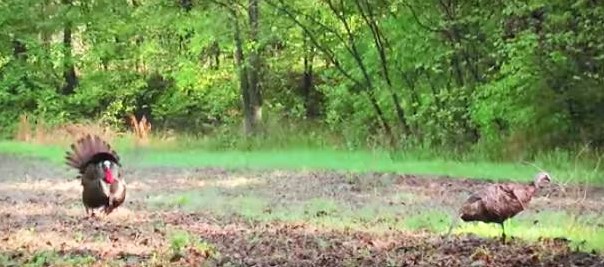Turkey Hunting Strategies: My Favorite Decoy Setups
Filed under: Hunting Blog, Turkey Hunting
I’ve recently shared tips from world champion turkey callers that will help us all become better at turkey calling and hunting this season. Becoming a proficient caller is the first key to get a tom to close the distance.
Once that tom has responded to the call it’s not uncommon for him to “hang up”. I’ve found that turkey decoys are an effective tool to encourage a tom to close the gap. (We use Montanna Decoys.)
My decoy setups are chosen based on the different hunting situations. These are things like the local terrain, where the birds are in the breeding season and the habitat. Below are several decoying strategies I use.

Lone Hen: My initial “go to” when I am turkey hunting is the lone hen. A lone hen has proven to be very effective in catching the attention of a gobbler. (The Miss Purr-fect by Montanna Decoys is the ideal decoy for the lone hen strategy.)
Jake/Hen combo: A jake decoy with a hen can be a strong attractant to a dominant tom. I use this combo frequently at the beginning of the hunting season when the toms are sorting out their dominance. I position the jake about two to three feet away from the hen then put the head up so that red head draws the attention of the dominant gobbler. It’s a good idea to put the lone hen in a feeder pose to create a more natural and enticing setup. Think about it: if both are upright and alert they are sending communicating that something has them nervous. As the season progresses, this remains an effective setup. As the days go on, hens leave and go sit on the nest. When it appears that a jake still has a hen with him it can make a boss tom jealous and get him fired up to come into range! One of my favorites is having a jake sit right behind a hen when she’s in the breeding pose.
Breeder Hen/Full Strut Tom: When toms are running together and working to sort out who’s the boss, another effective decoy strategy is to put a hen decoy in a breeding position in combination with a strutting tom. I set the Miss Purr-fect hen decoy on the ground (without a stake) in a breeder pose, then add a Papa Strut behind her. The local toms will see the “intruder” and come in to see who’s messing with their hen!
Three Hens: Setting up three hens is an almost irresistible setup for a tom. It’s especially effective if you’re hunting an area with bully jakes and gobblers won’t come in. But what gobbler is not coming in to three hens? When you stake out the hens, put one in the breeding pose, another in a feeding pose and another in an alert pose.
I mentioned above that we use Montana Decoys. These are easy to carry, multiple decoys can fit into your vest and they are very versatile. The days of lugging a bagful of hard, loud decoys are over! They just fold up to fit in your vest; they are adjustable and have different leg pole sleeves to enhance various poses. Think about the message you want to send when posing the heads of the decoys and add movement by using their Motion Stake.
We’ve used all these setups at different times and in different states. Each one has proven successful during the right conditions. When scouting and then during the hunt, read the mood of the turkeys and create your decoy strategy around those observations.
For more details on how to setup your decoys, click here to get a free guide from Montanna Decoy.
Chasing turkeys, setting up decoys and enjoying Creation,
Grant



